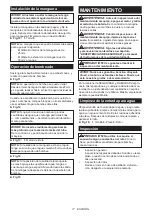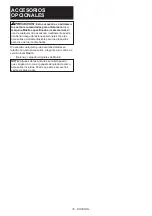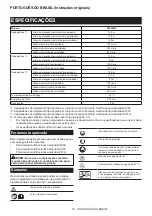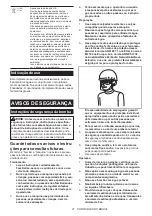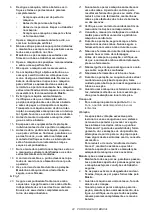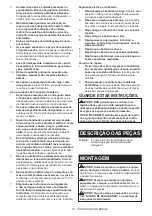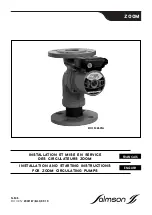
9 ENGLISH
Make sure that the surface of the lever is parallel to the
pipe.
NOTICE:
Do not tighten the lever without the
attachment pipe inserted.
Otherwise the lever may
tighten the entrance of the drive shaft too much and
damage it.
To remove the pipe, turn the lever toward the attach
-
ment and pull the pipe out while pressing down the
release button.
►
Fig.9:
1.
Release button
2.
Lever
3.
Pipe
OPERATION
WARNING:
Follow the warnings and precau
-
tions in the chapter “SAFETY WARNINGS” and
the instruction manual of the power unit.
CAUTION:
Do not operate the machine with-
out installing the hose to the pump attachment.
CAUTION:
When operating the machine, be
sure to fix the hose.
The hose may whip due to the
pressure of discharge.
CAUTION:
Adjust the hanger position and
shoulder harness to your comfortable position
before operating.
NOTICE:
Do not pump water containing large
amounts of solids or seawater.
NOTICE:
Do not pump water which exceeds
40°C.
NOTICE:
Drain water from the hose after the
operation.
NOTICE:
When moving the machine or changing
the operating position, be sure to turn off the
machine and hold the hose.
If you move without
holding the hose, the machine may be damaged.
NOTICE:
After pumping the sewage, pump the
fresh water to wash away the dirt adhering to the
water inlet and inside the hose.
NOTICE:
Do not place the machine on the
ground while it is switched on.
Sand or dust may
enter from water inlet and cause a malfunction or
personal injury.
Installing the hose
NOTICE:
When installing or removing the hose,
be careful not to splash water inside the hose on
the operator or the power unit.
Install the hose to the water outlet and fix the hose with
the hose clamp. Tighten the screw of the hose clamp
securely with a screwdriver.
►
Fig.10:
1.
Screw
NOTE:
The hose that can be installed to the water
outlet is as follows:
•
Inner diameter of hose is 25 mm.
•
Outer diameter of hose is 33 mm or less.
Pumping operation
Hold the machine firmly with both hands and perform
the pumping operation.
►
Fig.11
NOTE:
The pumping operation can be started from
the water level of approximately 20 mm, and can be
performed up to the residual water level of approxi
-
mately 10 mm.
When using the pump attachment in muddy or sandy
soil, lay down blocks or other materials, and use the
pump attachment on them.
►
Fig.12
NOTE:
Be aware that pumping large amounts of
water which contains fine particles such as sediment
will shorten the life of the pump attachment.
NOTICE:
Do not insert the pump attachment
deeper than the limit mark on the pipe.
Doing so
may cause a malfunction of the machine.
►
Fig.13:
1.
Limit mark
NOTE:
If the hose outlet is in water, be aware that
water will flow back when the pumping operation is
stopped.
►
Fig.14
NOTE:
If the position of hose outlet is lower than the
water surface, be aware that water will continue to
flow from the hose outlet after stopping the pumping
operation.
►
Fig.15
MAINTENANCE
WARNING:
Before inspecting or maintaining
the equipment, switch off the motor and remove
the battery cartridge.
Otherwise, the machine may
start unintentionally and result in serious injury.
WARNING:
When inspecting or maintaining
the equipment, always put it down.
Assembling or
adjusting the equipment in an upright position may
result in serious injury.
WARNING:
Follow the warnings and precau
-
tions in the chapter “SAFETY WARNINGS” and
the instruction manual of the power unit.
CAUTION:
Wear gloves when performing the
inspection or maintenance.
NOTICE:
Never use gasoline, benzine, thinner,
alcohol or the like. Discoloration, deformation or
cracks may result.
Summary of Contents for PF400MP
Page 2: ...2 Fig 1 1 2 3 4 5 Fig 2 1 Fig 3 3 2 1 Fig 4 2 1 Fig 5 1 Fig 6...
Page 3: ...3 1 2 3 4 5 Fig 7 1 Fig 8 Fig 12 3 1 2 Fig 9 1 Fig 10 Fig 11 Fig 12 1 Fig 13...
Page 4: ...4 Fig 14 Fig 15 2 1 3 Fig 16 Fig 17 Fig 18...
Page 36: ...36 40 C Ni MH Li ion 1 2 3 4 1 2 3 ANSI Z87 1 EN 166 AS NZS 1336 4 5 6 7 1 2 3 4...
Page 39: ...39 3 7 1 2 3 4 5 4 8 1 9 1 2 3 40 C 10 1 25 mm 33 mm 11 20mm 10 mm 12 13 1 14 15...
Page 40: ...40 Makita Makita 16 1 2 3 Makita 30 N No 2 17 Makita Makita 18 10 30...
Page 41: ...41 Makita Makita Makita Makita Makita...
Page 43: ...43 40 C Ni MH Li ion 1 2 3 4 1 2 3 ANSI Z87 1 EN 166 AS NZS 1336 4 5 6 7 1 2 3...
Page 46: ...46 1 5 1 2 2 6 1 3 7 1 2 3 4 5 4 8 1 9 1 2 3 40 C 10 1 25 mm 33 mm 11 20mm 10 mm 12 13 1 14...
Page 47: ...47 15 Makita Makita 16 1 2 3 Makita 30 Makita N No 2 17 Makita Makita 18 10 30...
Page 48: ...48 Makita Makita Makita Makita Makita...
Page 53: ...53 40 C 10 1 25mm 33mm 11 20mm 10mm 12 13 1 14 15 16 1 2 3 30 N No 2 17...
Page 54: ...54 18 10 30...
Page 77: ...77 40 C Ni MH Li ion 1 2 3 4 1 2...
Page 79: ...79 21 22 23 24 25 26 27 28 29 30 1 1 1 2 Makita 3 4 5 6 7 8 9 10 11 1 2 3...
Page 80: ...80 4 5 6 130 C 7 1 2 3 4 5 6 7 8 1 2 2 1 2 3 4 5 1 2 3 1 2 2 4 1 2 3 2 5 4 5 N m...
Page 81: ...81 1 5 1 2 2 6 1 3 7 1 2 3 4 5 4 8 1 9 1 2 3 40 C 10 1 25 mm 33 mm...
Page 82: ...82 11 20 mm 10 mm 12 13 1 14 15 Makita Makita 16 1 2 3 Makita N No 2 30 17 Makita Makita...
Page 83: ...83 18 10 30 Makita Makita Makita Makita Makita...
Page 84: ...84...
Page 85: ...85 15 3 2 1 16 N No 2 30 17 18 10 30...
Page 90: ...90 3 2 1 16 30 N No 2 Makita 17 Makita Makita 18 10 30 Makita Makita Makita Makita Makita...
Page 95: ...95...

















